August 19, 2022 – Volume 24, Issue 8
In This Issue
- Flanigan’s Eco-Logic: B Corp
- Sailing the Coast of Maine
- The State of Maine
- Day One: Falmouth to Sebasco
- The Maine Lobster Industry
- Day Two: Sebasco to Five Islands
- Day Three: Five Island to Damariscove and Booth Bay
- Day Four: Booth Bay to North Haven
- Energy in Maine
- Day Five: North Haven to Isle au Haut
- Day Six: Isle au Haut to Seal Bay
- The Lighthouses of Maine
- Day Seven: Seal Bay to Rockland
- Flanigan’s Ego-Logic Podcast Updates

Flanigan’s Eco-Logic: B Corp
EcoMotion is now formally a Benefit Corporation under California state law. Furthermore, and earlier this week, we were notified that we have been certified by B Labs as a Benefit Corporation (or B Corp), after a two-year process that included amending our Articles of Incorporation. The distinction codifies our practices and guides our future.
Certification is a huge stamp of approval and transparency. Our claims of being a deep green company, one passionate about the Earth, have been scrutinized and proven. I salute our team, led by Sierra and Alizeh, in the process of disclosing all clients and each job details, our financials, our resource consumption (electricity, gas, water, gasoline, recycling, etc.), as well as employee manuals and practices. In the end, we got 84 points, enough to pass muster!
We are proud to carry and promote the B Corp principles. We track and tighten our footprints. We are fulfilled by our solar and storage works and their carbon offset values. This is who we are and why we operate. We are guided by our beliefs. We do pro bono work. We only advance projects that are sound, economically and environmentally. EcoMotion has been doing beneficial work for some time. The B Corp status highlights this long-standing tradition of eco-conscious work.
EcoMotion very much looks forward to joining a cohort of B Corps in the Los Angeles area and beyond. The “B-Hive” of certified businesses is no doubt an interesting and committed group. As new members, we add our name to the following statement of principles.
Declaration of Interdependence:
We envision a global economy that uses business as a force for good.
This economy consists of a new type of corporation — the Certified B Corporation—which is purpose-driven and creates benefits for all stakeholders, not just shareholders.
As B Corporations and leaders of this emerging economy, we believe:
That we must be the change we seek in the world. That all business ought to be conducted as if people and place mattered. That, through their products, practices, and profits, businesses should aspire to do no harm and benefit all.
To do so requires that we act with the understanding that we are dependent upon another and thus responsible for each other and future generations.
Fact of the Week
“We’re a gas and diesel station. We do home heating oil. We have a tow truck. We also work on cars. We build floats, we build wharfs. We set moorings and we rent them seasonally, plus we set them for people who own their own. We have a scow, we have a Marine Travelift, we haul boats on land. We work on boats, so that’s fiberglas and wooden boats, outboards, inboards. Then there’s all the different types of boat work — things like fiberglasing, hull spray painting, regular painting, varnishing. And then boat storage and other storage. We rig sailboats for people. We give boating lessons. We’re also the ferry service between North Haven and Vinalhaven. We have the hardware store, we have everything from nuts and bolts to paint and sweatshirts.”
Sailing the Coast of Maine
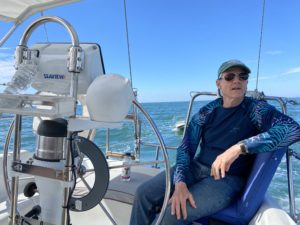
Rob Pratt has been sailing all of his life. His grandfather raced sailboats, as did his dad, and following their lead, so did all of his brothers and sisters. It’s in their blood. And now Rob takes the summer to do his thing… at least a solid month living on board his 35-foot Otay sloop Zephyr.
Rob is a work colleague for whom I have great respect. He’s founded four energy companies, including his latest venture in the Solomon Islands. For more on his works, check out our recent Flanigan’s Eco-Logic Podcast. Rob and I have been discussing sailing for years, and the notion of joining him for a Maine cruise began to gel two years ago, pre-covid. Then finally, in late July, Terry and I were bound for Maine to sail the coast with Rob for a week… and what an experience we had.
We fly to Portland, Maine a day early to help provision the boat for a week. We sneak in our first taste of lobster at Lukes on the pier downtown. The next morning, Rob and I confer about food and preferences… and Terry and I hit Whole Foods hard. Lots of organic snacks, veggies, fruits, cereals, almond milk, etc. The next day, Rob picks us up at our hotel. Between our luggage, my road guitar, and bags and bags of groceries, we were laden with gear. I quipped that Rob had better not show up in a Prius. Hah! He does. Somehow, we squeezed it all in with few square inches to spare.
Mercifully, it’s a short drive from the Portland Jetport to the Handy Boat Marina in Falmouth. There, we buy ice and take the launch to Zephyr where we pack the two ice boxes on board and stow the wine, ready for departure.
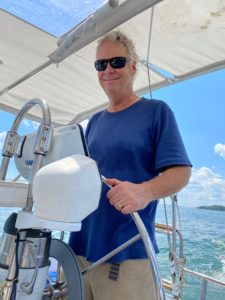
The State of Maine
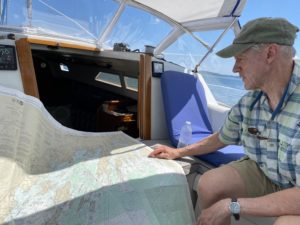
Let’s take a quick look at the State of Maine. It’s population of 1.34 million in 2020 makes it the country’s 9th least-populated state. What are the least populated you ask? 1. Wyoming (581k), 2. Vermont (623k), 3. Alaska (724k). Maine is the most sparsely populated state east of the Mississippi. It was added to the union as the 23rd state in 1820. Four-fifths of its land area is forested.
Maine is the nation’s northeastern-most state. It is the largest of the six New England states, known for its rocky and rugged coastline. Many of its granite islands are covered with spruce trees. The State is 35,380 square miles in size; it comprises fully one-half of New England. It includes 2,300 square miles of inland lakes. The last glacial period was 18,000 years ago. At that time, ice scraped slowly over Maine’s granite at a rate of a foot a year. This carved the granite to its form today… north-south striations forming this wild and crazy coastline.
From its southern border to its northernmost coast is ~250 miles as the crow flies. But that does little to explain its coastline, a convoluted coastline of 5,500 miles wrapping around the State’s 6,200 islands.
Rob says that this coast is his favorite cruising area. He’s just back from doing “the catamaran thing” in the British Virgin Islands. That’s a different experience indeed. The Maine coast is dotted with islands, quaint fishing villages, and resort towns like Booth Bay and Bar Harbor.
Maine is an archipelago with more islands than Polynesia or the Dalmatian coast in Croatia. One-third of Maine’s islands are 10 acres or more in size; 15 are inhabited year-round; and 20 have scheduled ferry service. Federal and state agencies own ~1,500 islands. Others are managed by The Nature Conservancy, the Maine Coast Heritage Trust, and local land trusts.
From a sailor’s standpoint, there are many islands to explore… and many, many dangerous shoals to avoid. This must have been a shipwreck capital in the day. Today, sailors rely on GPS and depth finders to show us where to sail, and where to steer clear. Sailors track the tides carefully. For sailors, there are three key hazards: rocks, fog, and lobster buoys!
Day One: Falmouth to Sebasco

The adventure begins. We head north, beginning of our 250-mile voyage up the coast. I am immediately struck by the preponderance of lobster pots and their buoys that severely challenge boaters. Unregulated as to where they can be dropped, they form an endless, weeklong obstacle course.
We motor through Casco Bay, ultimately passing the island home of Rear Admiral Robert Peary, credited as the explorer who first traversed land and ice to reach the North Pole in 1909. He used sled dogs to do so, traversing Greenland on his route north. Later in life, he summered on his private Eagle Island on the Maine coast. He reportedly kept his sled dogs in the mainland to keep his island free from barking!
Our first stop is Sebasco, a marina at one of Maine’s many summer camps. The Sebasco Harbor Resort has the steepest mooring fee we’d pay all week ($50) but included use of the pool and access to the restaurant and bar there. We mount Rob’s Torquedo electric outboard to the dinghy… attaching its shaft, battery pack, and rudder/controller. It’s quiet and clean and a bit temperamental.
Rob notes that Sebasco’s classic and huge and waters-edge saltwater pool has been replaced with a brand new, freshwater pool. It’s clearly popular with kids and their parents. I jump in and splash about before we tour the aging resort and its outbuildings. We wonder how this place survived the pandemic. After cocktails of wine and cheese on board Zephyr, we dinghy in again for dinner. The bar/café is packed and we suspect that labor shortages have caused Sebasco to close its formal dining room. We’re lucky to get served and we eat our favorite combination of a lobster roll with clam chowder.
A great meal we had. As we leave the café there is no moon. It’s totally dark when we’re done eating. We head down the dock to retrieve the dinghy. For a while and as our eyes become accustomed to the lack of light, we motor about in the marina unable to spot Zephyr! From then on, Rob turned on the “anchor light” atop the mast to mark our boat when we go ashore. And yes, LEDs have made it to the yachting world, each captain familiar with the color temperature of his or her anchor light.
The Maine Lobster Industry
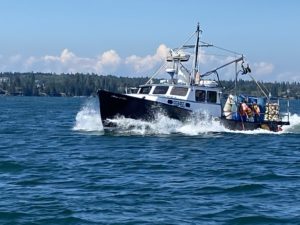
Maine’s lobster industry is a $1.4 billion dollar industry. There are some 3 million lobster traps, or “pots” as they are called. They are hugely challenging for sailing… we weave through fields of pots. For Maine lobstermen, there have been good years of late… some 120 million pounds of live lobster each year. (Note that it takes 5 – 6 lobsters to produce 1 pound of lobster meat.)
But that’s the good news. The bad news is that climate change is drawing lobsters north as they seek cold waters. The lobster industry has already been shut down in Connecticut, Rhode Island, and Massachusetts. That’s worked well for Maine, given it a big edge on the competition. But many fear that Maine’s waters will warm and will no longer be suitable for lobstering. In the coming years, the lobsters will go north to Canada.
Another factor facing the industry relates to right whales. They are endangered and there are only 350 left worldwide. There are concerns that they are getting entangled in fishing lines – and some say in lobster pot lines — and so there may well be regulations to protect them that could restrict the lobster industry. Another factor is that haddock is favored chum (bait). Haddock fishing has been regulated resulting in a shortage of lobster chum, and thus price hikes. And then the pandemic depressed lobster prices due to less demand. Lobster was seen as an expensive luxury. Now fuel prices have risen sharply, further challenging the financial viability of lobstering. Lobstermen are tending to their pots less to save fuel.
It’s a tough way to make a living… out on the open waters year-round harvesting. Each lobster boat has a boom and electric winch on its starboard side to raise the pots. On the trip, we have lots of time observing the lobster boats, and their crews raising the pots which they open to harvest lobsters. Seagulls love this as the lobstermen discard seaweed and crabs; they also release female lobsters with eggs and lobsters that are too young.
Day Two: Sebasco to Five Islands
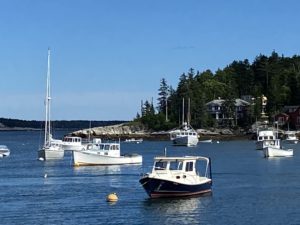
Day Two and we are off to Five Islands. Tiny and hugely scenic, the Five Islands harbor at Georgetown is perhaps my favorite port of call. We dinghy ashore and hike up the hill to buy fresh lettuce and tomatoes from a farm stand. We share some wine at harbor’s edge and then stroll over to the town dock which features a lobster shack and lots of picnic tables on the pier.
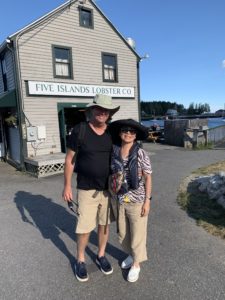
Terry orders a 2-pounder and is in heaven. Rob and I grin and chow down on corn and steamers and our lobsters. What a mess. It’s awesome. Later back on the boat we sing.
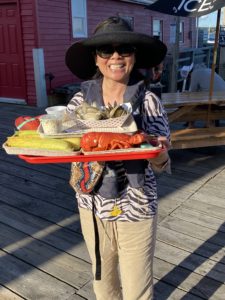
Five Islands is an idyllic harbor mixing of lobster and pleasure boats. We see this combination of strange bedfellows throughout our trip. We learn about resentments between the lobstermen, and the ‘yachties,” folks like us sailing for fun. We are without their financial concerns and realities of the hard-core lobstermen… many of whom ply these waters year-round in all sorts of inclement weather and frigid temperatures.
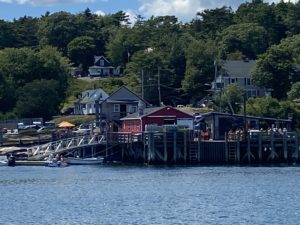
I get up early on day three for some guitar playing and a quick dip in the waters. It took me a while to take the plunge… pushing myself to go for it. I think of my favorite cold-water swimmer, Anna Rumsey. What would she do? Hey, you only live once! But after I dive in and hit the water, I reassessed my sanity. That’s very cold water. I gasp and quickly flail back to our boat and its swimming ladder. Nothing graceful about it. Who needs coffee with that kind of stimulant lapping at our boat and its grey hull?
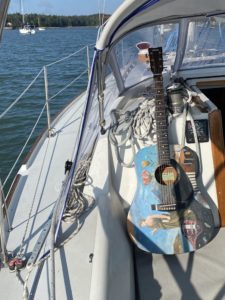
Day Three: Five Islands to Damariscove and Booth Bay
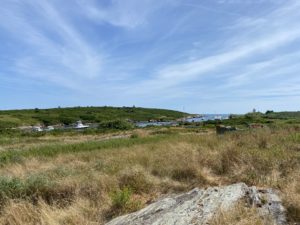
Day three was our biggest sailing day. We pass by Booth Bay and head to Damariscove Island. It had been inhabited years ago… before the Pilgrims. It has a rich history of fishing and shipping. Granite was quarried there. By 1900, however, the population had reached its peak and then declined. Today there is only one private residence there. Its narrow cove offers shelter for only a handful of boats.
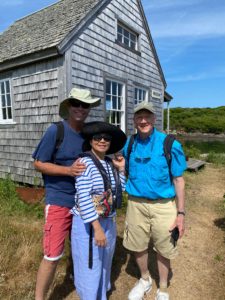
We visit a tiny museum. We meet the island’s summer caretaker. She and her husband are given a small cottage. Apparently, people apply for these remote summer positions. What a way to get away from it all. We also chat with a young and quite buff young man who has sailed his 14-foot catamaran solo from Booth Bay. Impressive sailor indeed. We give him an apple and name him Tarzan.
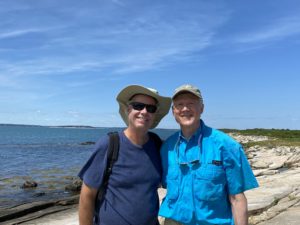
Leaving Damariscove, and at Zephyr’s helm, I spot a creature in the water that I did not recognize. To me, it looked like a dead dolphin on its side. What the heck was that I thought?
Rob saw it too and reported that it was a sunfish… a rare sighting. I learn later that the Ocean Sunfish is not often sighted in the coastal waters of Maine. This is the northern-most point of their range; they are only to be found in Maine during the hottest parts of the summer. But these days and given warmer ocean temperatures, they are being sighted more and more, laying on their side… almost prehistoric. They are the heaviest known bony fishes in the world, from 545 – 2,205 pounds in weight. Sometimes they resemble a shark; they produce more eggs than any known vertebrate… up to 300 million at a time.
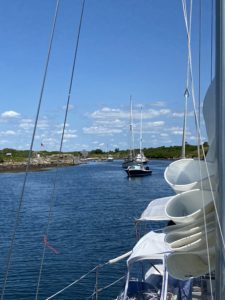
We double back and head into Booth Bay, one of Maine’s most popular tourist towns. There are two huge sailing ships in the harbor, one gorgeous ship from Australia with four spreaders for the stays that support its massive mast. The boat dwarfs a crew member on deck. After a quick dinner on board, we head into the Tugboat Inn Marina for showers and a hike to the local Hannaford’s to buy more ice. The coin-operated showers sure feel good.
Day Four: Booth Bay to North Haven
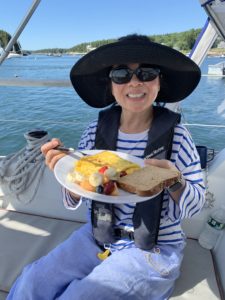
Day Four and we begin with Rob’s signature omelets! Yum! We cross Penobscot Bay to North Haven. It’s about a sixty-mile crossing and finally we moored at the J.O. Brown marina and boatyard. Talk about picturesque, old and classy.
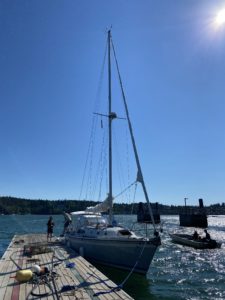
I read later that the shipyard was founded in 1888 and that today, a fifth generation Brown still builds boats there. We fill up Zephyr’s water tanks with fresh water at the dock and top off our fuel tanks. I am struck by how little diesel we’ve burned since leaving Falmouth.

I love the boat yard’s shop. A huge wood planer bears witness to lots of use. There’s a huge pile of shavings. We check out an old dinghy mounted on the dock. Water pours into it and out of it, continually. It’s full of lobsters that boaters can take, and pay for using the honor system.
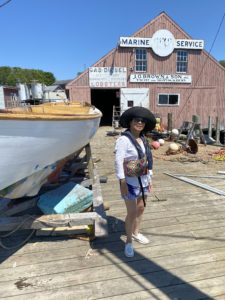
Energy in Maine
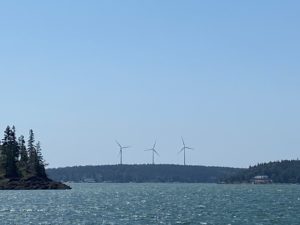
I spot Vinalhaven’s three wind turbines from far away. They were built in 2009, three, 1.5 MW GE turbines that rise 388 feet in height. Some call them “eerie” as their scale is so much larger than anything else around. They make up the largest community-owned wind on the East Coast. They are owned and operated by Fox Island Electricity Cooperative that serves the islands of North Haven and Vinalhaven. The $14.5 million project was overwhelmingly approved by the Coop’s members (382 – 5) as a means to serve the power needs of the two islands’ year-round residents, and to lower their rates.
Maine has a 4,875 MW summer peak power demand. In 2020, 79% of the State’s electricity was generated by renewables: hydro, wind, wood, and wood-derived fuel. There are 102 licensed hydro facilities in Maine. Maine Yankee, the state’s only nuclear plant, was closed in 1997. It operated in Wiscasset.
There is no coal mining in Maine, and the State’s sole coal plant was built in 1990. Today, less than 1% of the State’s electricity comes from coal. The 102.6 MW Rumford Cogeneration Plant burns biomass and coal and is privately operated by ND Paper to serve its pulp and paper mill in Rumford.
Day Five: North Haven to Isle au Haut

Day Five and after exploring North Haven and its community center, we release our mooring and motor through the Fox Island Thoroughfare heading east. Both shores are lined with gorgeous summer cottages… read mansions. Once through the Thoroughfare, we set the course towards Isle au Haut.
Exciting is the fog bank that we encounter, and Rob turns on Zephyr’s radar. There’s lots of fog in Maine. It’s formed by warm continental air flowing over cold waters, causing moisture in the air to condense. Rob instructs me to get the foghorn blaster to alert other boats of our presence if need be. Through it all, we’re dodging lobster pots. After a piece, we’re out of the fog and close to Isle au Haut… arriving in its wharf area in time to motor ashore and check out its tiny market.
I’d texted my longstanding friend Mat Hastings who owns a house there… the “Stone Cottage,” just up from the wharf. There is no stone in this lovely stick-built home. Instead, it was built by U.S. Supreme Court Justice Stone in the 1920s. We miss Mat by three days but stop by his house and find that he has donated it for a week to a school’s raffle fundraiser. His guests are thrilled to be there and are warm, intrigued by this guy Mat who has photos of himself with Hillary and others in the upstairs hallway.
I learn more about Isle au Haut. For those without their own boat, it is accessed by ferry from Stonington, a village on Deer Island. Isle au Haut is five miles south of Deer Island. It’s remote and small, about six by two miles in size. I learn that it got electricity from the mainland in 1970 and phones in 1988. It is known for its unregistered “island cars:”
Since there is no car ferry, only infrequent barges bring cars and trucks to the island… and they rarely leave, cobbled together by crafty mechanics. We heard about the island getting its first fire truck. In an unusual arrangement, one half of the island is part of Acadia National Park. There’s good hiking there, and freshwater Long Pond where the fire truck fills its tank.
Day Six: Isle au Haut to Seal Bay
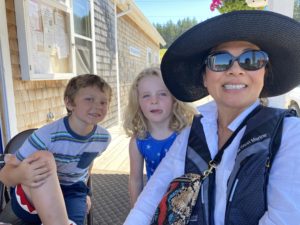
Day Six, we rise, have a pancake breakfast on the boat. (Vicki, Rob can cook!) We dinghy to the wharf, walk to the store, and tap into the internet to take care of critical communications. We then have a lobster roll lunch served up by the Lobster Lady. Two local kids – Gabe and Audrey — entertain us as we eat. Gabe is matter of fact about living on the island and shows off his worldly knowledge. He quizzes us: What’s the tallest building in the world? We were stunned that he knows about the Burj Khalifa in Dubai! Rob does straighten him out on some other urban facts.
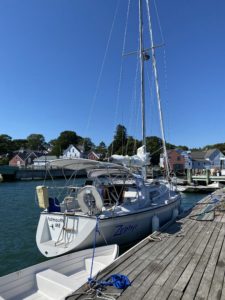
Back to Zephyr and we’re headed out of the harbor, doubling back and on our way to Seal Bay, a pristine and secluded bay on Vinalhaven. It is postcard perfect on a sunny afternoon. Other boats have found this spot too! We work our way into Seal Bay’s headwaters, bathing in the sights of the rocky Maine coastline… tidal waters and pine trees close to shore. This spot is remote; there are no moorings or docks or anything here. Just the splendor of nature on a nice, warm summer day in Maine. We drop anchor and without adieu, I take my second baptismal dip of the trip. This time Rob joins me, enticed by the Bay’s relatively warm water.
The Lighthouses of Maine
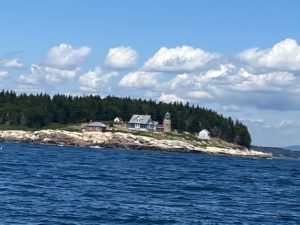
Today there are 63 lighthouses in Maine. There used to be many more, manned ones to boot. The first was built during George Washington’s first term in 1791. (GW commissioned Long Island’s Montauk point lighthouse at that time too.) In their early years, the lighthouses used whale oil to fuel their lights. Later, they were switched to kerosene. The lighthouse keeper’s duty was to keep the wicks trimmed and to wrap the weights used – like a cuckoo clock — to turn the lights. Later they were upgraded with large refracting prisms, Fresnel lenses, that increased their range and brightness. Today, Maine’s lighthouses are unmanned, their lights and foghorns fully automated. On Isle au Haut, there is a lighthouse AIRBNB.
Day Seven: Seal Bay to Rockland
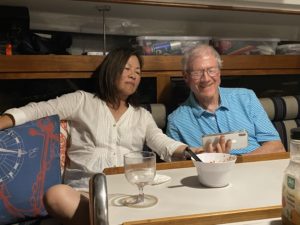
Day Seven, we leave Seal Bay and double back through the Fox Island Thoroughfare on our way to Rockland. It’s our final destination. There, we fill the water tanks, fuel up, gather the laundry, and head into the marina office. Terry disembarks, happy to be ashore after a week at sea. Rob and I then take Zephyr to its mooring.
Without question, we were blessed with fantastic weather… no rain or prolonged fog, just sunny days, cool temperatures, and moderate winds. Nothing too severe! And more so, we were lucky to be Rob’s crew for a week. He is a trip leader extraordinaire.
We leave Rob with hugs and big thanks. He has a single night of peace and quiet and space before his next crew arrives. Terry and I pick up our car rental at the Rockland airport in Owl’s Head and drive north, stopping at a lobster pound for dinner. We’d then spend two nights at the wonderful Bar Harbor Inn, the perfect antidote to glamping about Zephyr. For at least 24 hours, an on terra firma, I feel the sway of the ocean, my internal stabilizers still not so sure that they can shut down.
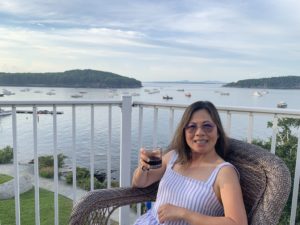
Flanigan’s Ego-Logic Podcast Updates
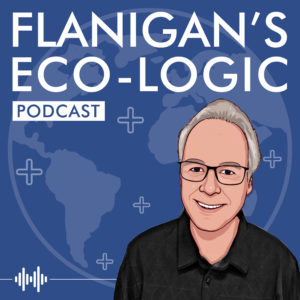
Recently Released:
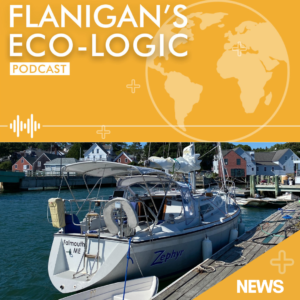
This issue features Ted and Terry’s recent trip sailing 250 miles in Maine. Rob Pratt is a great friend and hugely seasoned sailor with a love of this rugged coastline. He welcomed us aboard his 35-foot Otay for a week of gorgeous views, sunny weather, mild winds, record amounts of lobster, inspiring conversations. The issue is a travelogue takes you on board and through our adventure. It is sprinkled with insights on Maine’s coast, energy in Maine, the lobster industry, and its 63 lighthouses.
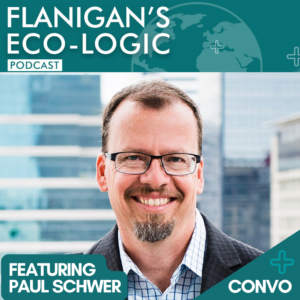
In this episode of Flanigan’s Eco-Logic, Ted speaks with Paul Schwer, President at PAE Consulting Engineers, Inc. As the president of PAE, Paul leads a talented group of over 380 engineering, design, and business professionals creating the most energy and water efficient buildings in the world.
Paul explains his attraction to the Living Building Challenge, and how it is the next step past LEED. Paul goes on to highlight the potential for timber framing, the PAE office building using waste as a product, and the concept for the “Irresistible Stairway” at the Bullitt Center. He also digs deeper into changing human behavior through curiosity, and expanding our thinking through our connection to nature.
